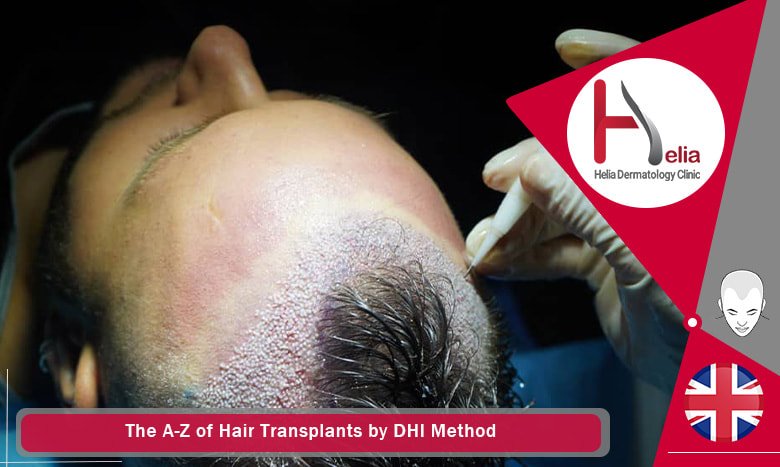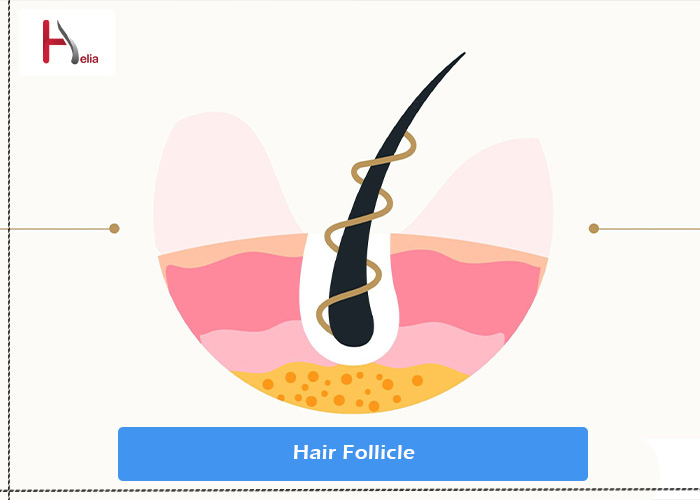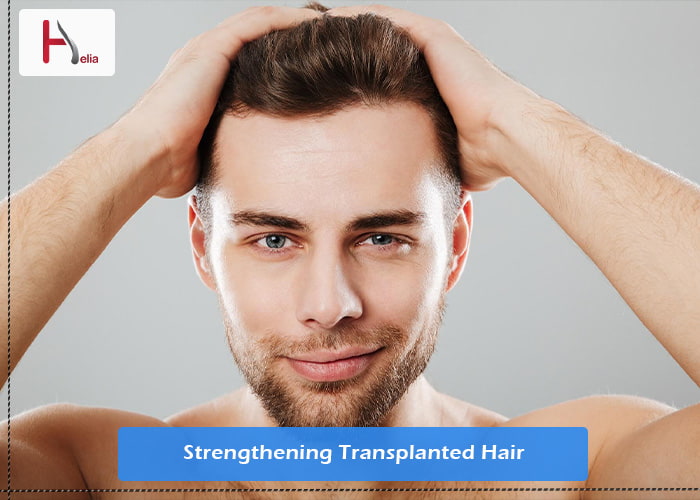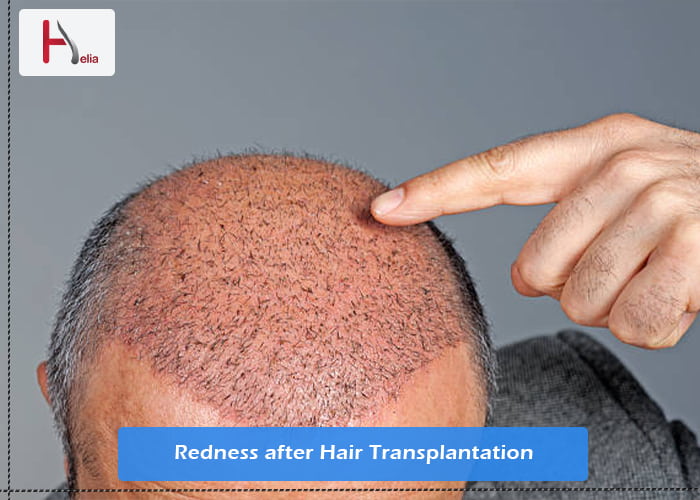For many years, human beings have made endless efforts to beautify their appearance. Meanwhile, continuous efforts to restore the volume of lost hair led to the invention of a method called natural hair transplantation. It did not take long for different methods to be proposed for this operation from all over the world.
One of the newest and best hair transplant methods that is used today in prestigious clinics in Iran, Turkey, UAE and other parts of the world is DHI hair transplantation. In this method, the applicant’s own hair is used for transplantation, and in this regard, DHI hair transplantation is a non-invasive and guaranteed method that has been very effective in restoring the hair. Direct Hair Implantation (DHI) is a corrective procedure for the FUE method introduced by DHI Global Medical Group.
In fact, by using hair transplantation by the DHI method, the hair transplantation tool practically replaces the doctor’s hand, and this issue not only increases the accuracy and speed of work but also prevents the possibility of infection and also prolongs the implantation process. One of the hair transplant centers by DHI method is Helia dermatologic clinic with the valuable presence of Dr. Khorasani. In this center, we are ready to provide beauty services to all aspirants with the highest percentage of efficiency and the lowest complications.
How Does the DHI Method Work?
DHI is a modified version of the FUE hair transplant, and both methods follow a similar procedure. For natural hair transplantation by the DHI method, the surgeon removes hair follicles from the scalp using a special pen with a thin tip and places them on the bald areas of the head without any delay or scratching. These follicles eventually cause new hair to grow. In fact, the difference between this method and FUE is that in the FUE method, first the follicles are extracted from the back, in the second stage, the doctor uses special tools in the bald area to create a series of points for hair follicle transplantation, and in the third stage, the extracted follicles are put inside these holes.
But in DHI hair transplantation, the second stage of FUE is eliminated, and hair transplantation is done directly and without delay. The pen-like device itself has both scratches and grafts. Just like injecting the medicine.
| Analyzing the Disadvantages and Advantages of Direct Hair Transplantation or DHI | ||
| Planting Steps | Advantages | Disadvantages |
| 1- DHI is a modified version of FUE hair transplantation and requires shaving the donor area. Therefore, before starting the implantation process, the hair of the donor area should be shaved so that the grafts can be extracted easily. | 1- As with all methods derived from the FUE method, at the end of DHI hair transplantation, no scars remain on the back of the head that is selected as the hair source.
| 1- If this method is performed by an inexperienced physician, severe side effects such as severe bleeding, dizziness, pain, increased heart rate, inflammation of the hair follicles, scattered and undesirable appearance around the donor area and scarring may occur. |
| 2- The doctor marks the areas to be implanted with a marker to know where each graft should be grafted. In this way, a natural and beautiful hair growth line will be created. | 2- The survival rate of follicles after implantation by the DHI method is more than 90%. Therefore, the result of this hair transplant will be dense and natural. | 2- The number of hair transplants in one session with DHI hair transplantation is between 1500 and 3000 grafts, which is less than some other methods. |
| 3- For the convenience of the patient and to facilitate the work of the physician during DHI implantation, the areas of the hair source and the receiving area are placed under local anesthesia by drugs such as lidocaine (injectable). | 3- The recovery period after DHI hair transplantation is much shorter than other methods, especially those that follow the FUT method. In this way, people will no longer see the effects of small wounds and scabs after 15 to 25 days after hair transplantation. | 3- Not suitable for very wide baldness. |
| 4- The surgeon uses a sharp instrument to begin extracting hair follicles from the backside of the head, and this extraction will continue until the number of grafts is sufficient. The important thing about this method is that the hair follicles are removed one by one from the scalp and attached to the bald area. | 4- The number of sessions of this type of hair transplant in most cases is only one session and the whole work is done with this one session. | |
| 5- Hair follicles are loaded in a tool in the form of a pen and are grafted at the bald part of the scalp at appropriate and sufficient distances. | 5- Hair transplantation by the DHI method can be done for women and men over 21 years old who have baldness or thinning hair for any reason. | |
| 6- After the hair transplant, which may take about 8 hours (depending on the number of grafts transplanted), the surgeon applies antibiotic cream to all parts of the head and covers it with special bandages to prevent infection. | ||
| 7- The final results of DHI hair transplantation take about 12 to 18 months. | ||
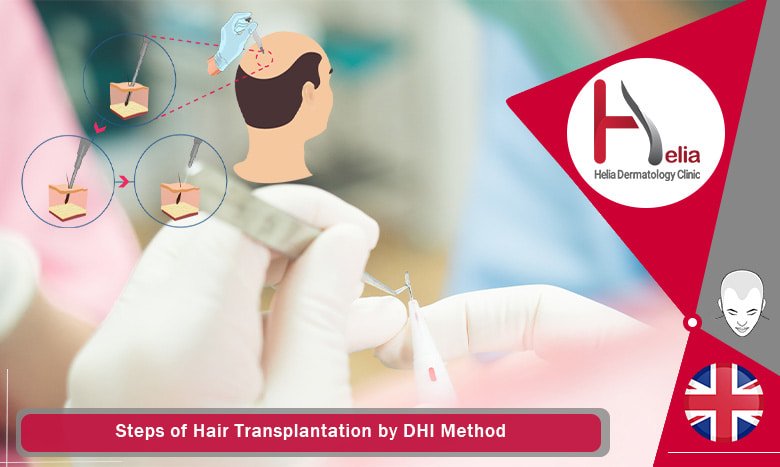
Steps of Hair Transplantation by DHI Method
- The specialist shaves the person’s head and uses local anesthesia to numb the area.
- Using a fine-tipped pen-like tool, the doctor removes hair follicles from the person’s hair source.
- The hair follicles are placed in a pen tool and attached to the bald area of the scalp by pressing the piston.
- At this stage, antibiotic cream is applied to the donor and planted areas of the follicles and the bandage is applied to the implanted area.
How long does the DHI method take and when are the results visible?
FUE and DHI surgery generally take about 6 to 8 hours. However, the exact time depends on the number of hair follicles transplanted. It may take 10 to 18 months to see the full results of a natural hair transplant by DHI.
For information about the price of your hair transplant, you can contact Helia Dermatology Clinic to get free consultation through the number +971 56 100 3040. Also, share all your questions about hair transplantation and other beauty services with us via WhatsApp messenger at +971 56 100 3040.
Side Effects and Precautions of DHI Hair Transplantation
DHI hair transplants are relatively safe and rarely cause any side effects. DHI and FUE are less invasive than other hair transplants because they do not require a strip cut at the back to obtain a graft. The DHI technique causes some small scars on the scalp. These scars are usually not noticeable. However, if this procedure is performed by an unskilled and untrained physician in an unreliable clinic, severe complications may happen to the applicant. Here are some possible side effects of visiting an unreliable DHI hair transplant center:
- Negative reaction to anesthetic: During DHI hair implantation, local anesthesia is performed to avoid pain. This anesthesia is generally safe but may cause adverse reactions in some people. Of course, the vast majority of reactions are related to fear or anxiety, not a local allergy to the drug.
- Infection: Infection may also occur at the donor site (hair bank) or in the area where the hair follicles have been implanted (recipient). Serious infections are usually rare and occur in less than 1% of cases. This is often due to the negligence of the novice operator.
- Excessive hair loss shock: Hair loss shock can occur within 2 months after DHI hair transplantation, which is often temporary. After that, complete recovery takes about 3 to 4 months. But if implanted in unreliable centers with inexperienced staff, most grafts may be lost forever. It also depends on how the person takes care of the grafts.
- Adverse Appearance: When hair follicles are grafted, they should be aligned so that they grow naturally and in the direction of the individual’s own hair. If the follicles are implanted improperly and not in the same direction as the growth of other hairs, it may lead to an appearance that the person is not satisfied with.
- Bleeding
- Vertigo
- Pain
- Increase in heart rate
- Inflammation of hair follicles
- Improper appearance around the donor graft area
- Scarring
Additional Description about DHI Hair Transplant
The client’s growth line is measured with a three-dimensional laser device that is in harmony with the anatomy of the person’s face, and this is done by Dr. Khorasani, who has 16 years of experience in hair transplantation. Because the growth line is one of the most important parts of hair transplantation and because of its sensitivity in the face, Dr. Khorasani personally implants this part. According to the above description, the Hair Transplantation by Micrograft method is not just a DHI device or an implant device, but a total of three implant methods. Unlike other clinics where the whole process (extraction and implantation) is performed by technicians, in Helia Clinic, important parts of implantation work and complete supervision in other stages are performed by Dr. Khorasani with 16 years of experience in hair transplantation.

In general, DHI is not a method and is a tool used in hair transplantation that can cause more density, without scars. But some medical centers sometimes refer to DHI practically or inadvertently as a hair transplant method, whereas it is a tool for the micrograft method, which is performed completely and exclusively by Dr. Khorasani himself in Helia specialized Clinic.
DHI is sold in various sizes and dimensions in global markets. It has different types and is used separately for hair, hairline, eyebrow implants and beard implants. DHI is offered in different colors, each of which indicates its type and use in different areas of the head and face and if the color and size are not paid attention to, the candidates will not get the desired result from this tool. In general, green color is used for beard implantation, the blue color is used for growth line, red color is used for hair transplantation and green color is used for eyebrow implantation.
Apart from this, the doctor, depending on the type of hair source can sometimes use different colors for implantation, other than of the above conventional methods. Because the type and thickness of hair strands are different. Fortunately, Dr. Khorasani, due to his brilliant record in the field of implantation, has the necessary skills in using DHI tools in micrograft and SUT methods.
Pre-Op Recommendations for DHI hair transplantation
- It is forbidden to smoke or drink alcohol for one month before the hair transplant.
- Do not take blood thinners for two weeks before starting work.
- Don’t forget to tell your doctor if you have a specific illness, allergy to medication, or if you are allergic to an anesthetic.
- Be sure to take a shower the night before the hair transplant.
- On the day of the operation, wear button-down clothing so that you do not have trouble changing it.
Post-Op Recommendations for DHI Hair Transplantation
- Smoking and alcohol should still be stopped for up to a month after a hair transplant.
- Do not put pressure on the planting area under any circumstances, so be careful when sleeping. You should also not wear hats or scarves. You are only allowed to use the hat prescribed by your doctor.
- Take all prescribed medications.
- Increase your consumption of water, fruits and vegetables.
- As long as the expert recommends, the head should be higher than the body during sleep.
- To wash your head, you should use only the prescribed shampoo as long as your doctor tells you to.
- The use of a hairdryer is only possible under a doctor’s prescription.
- Avoid exercise and strenuous activities until further notice.
Who can go for hair transplantation with the DHI technique?
People with androgenetic alopecia (the most common cause of hair loss) are the best candidates for DHI hair transplants. Androgenic alopecia is commonly referred to as male or female pattern hair loss. The following characteristics also make people a good candidate for DHI hair transplant:
- Age: People who plan to have a DHI hair transplant should be over 25 years old because the amount and type of hair loss before this age is more unpredictable.
- Hair diameter: People with thicker hair usually get better results than people with thinner hair because thicker hair covers more of each hair follicle.
- Donor hair density: people with a hair density of fewer than 40 follicles per square centimeter at their donor area are considered unsuitable candidates for straight hair transplants.
- Hair color: People who have light hair or hair color close to their skin color often get the best results.
- Expectations of people: Those who have realistic expectations of this method will most likely be more satisfied with their results.
Recovery Period After DHI Implantation
- If you want to take a rest after surgery, it is better to place your head at a higher level than your body for a few hours to avoid the contact of natural hair transplantation parts with the ground or pillow.
- Avoid rubbing, itching or touching the natural hair transplant area during the recovery period after implantation.
- To wash your hair in the early weeks, special shampoos or hair lotions are usually recommended, so it is better to consult your specialist first.
- Try to take all the medications prescribed by your specialist doctor regularly.
- Avoid taking anti-inflammatory drugs, herbal supplements, anticoagulants, aspirin and warfarin to prevent infection and bleeding. Smoking can also slow down your recovery after a DHI hair transplant.
- In the first weeks after hair transplantation, avoid direct sunlight and heat to the hair transplant area and avoid strenuous activities such as boxing, martial sports, weightlifting for a few weeks.
- Sexual relations should be avoided for at least 10 days
- Eat healthy foods such as chicken, red meat, bananas, avocados, rice, nuts and eggs during your recovery.
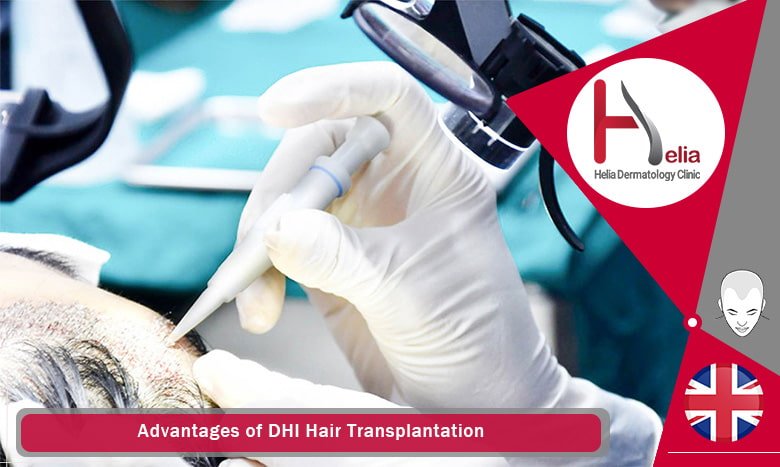
Advantages of DHI Hair Transplantation
- Like all methods derived from the FUE method, at the end of DHI hair transplantation, no scars remain on the back of the head, which is selected as the hair donor.
- The survival rate of follicles after DHI transplantation is more than 90%, so the result of this hair transplant will be dense and natural hair.
- The recovery period after DHI hair transplantation is much shorter than other methods, especially those that follow the FUT method. In this way, people will no longer see the effects of small wounds and scabs after 15 to 25 days after hair transplantation.
- The number of sessions of this type of hair transplant in most cases is only one session and the work ends with this one session.
- Hair transplantation by the DHI method can be done for women and men over 21 years old who have baldness or thinning hair for any reason.
Necessary Tests Before DHI Hair Transplant
Before the operation day, the medical staff usually asks the patient to check some important factors in their body during a simple test and present the results to the clinic. These tests are to check and maintain the health of the person and are usually as follows:
- Complete blood count (CBC)
- Experiment to examine the factors involved in blood coagulation
- Immune testing, which is for diseases such as hepatitis, HIV, etc
- Check blood pressure
- Check blood sugar levels and diabetes
Difference Between DHI Technique and Other Methods
- During FUT hair transplants, the surgeon cuts a long, thin strip of skin from the back of the person, and after extracting the follicles and refining them, they are implanted along the hairline. This is usually the fastest and cheapest method, but it can leave a scar. In contrast, during the DHI procedure, no crescent-shaped scar remains because each follicle is extracted separately and then implanted in the head.
- It is true that during the DHI and FUE methods, each hair follicle is removed directly from your scalp, but during the FUE, the surgeon manually creates the canals in the person’s scalp so that he can insert the hair follicles into them at the end. The DHI technique allows the doctor to make these incisions at the same time as the hair transplant, thereby speeding up the implant process.
Stages of Hair Regrowth After DHI Hair Transplantation
The hair growth process after DHI hair transplantation is a bit long, so if you are going to have hair transplantation, you should also practice patience, because it takes time for your newly transplanted hair to reach the density of hair on your head. Read step-by-step hair growth after DHI hair transplantation below:
1 month after hair transplantation: After one month of DHI hair transplantation, scabs and inflammation in the treated area disappear and the implanted follicles enter the resting phase. At this stage, also called “follicular shock”, there will be no hair in the implanted areas. This is normal and we will see hair growth over time. After this month, the person will not have any pain or burning or swelling in his hair donor area, however, it is necessary to take good care of the health of this area to prevent infection.
3 months after hair transplantation: In order to be able to see the results of DHA hair transplantation, you have to be a little patient because the first results of natural hair transplantation can be seen after three months. At this time, the newly implanted hair, although thin and pale, begins to grow, causing the scalp to look prickly. Maximum healing of the hair donor area and elimination of the possibility of infection will also be expected.
9 months after DHI hair transplantation: The hair starts to thicken and its color becomes more similar to other hairs, and in addition, you will have a complete recovery of the hair donor area in appearance.
1 year after DHI hair transplant: During this period, you should see your surgeon at least 2 times to check the hair transplant area. After 1 year of hair transplantation, a dense and natural volume of hair will be visible
How much does this method cost?
The cost of DHI hair transplantation depends on several factors:
- The clinic where the hair transplant is performed.
- The amplitude of baldness and number of follicles required
- Hair donor type and its density of hair
- Type and thickness of hair
- Person’s age
- Specialist wage
- Prescribed drugs
- Treatment of possible complications
- And…
dhi vs fue
FUE (Follicular Unit Extraction) is a hair transplant technique that involves extracting individual hair follicles from the donor area and transplanting them into the recipient area. FUE is a minimally invasive procedure that does not require any cutting or stitching.
DHI (Direct Hair Implantation) is a hair transplant technique that involves extracting individual hair follicles from the donor area and transplanting them directly into the recipient area. DHI is a more invasive procedure than FUE, as it requires the use of a special implanter tool to insert the hair follicles into the scalp. DHI is also more time-consuming than FUE, as each follicle must be inserted one-by-one.
For information about the cost of DHA hair transplantation, you can contact the consultants of Helia Dermatologic Clinic, completely free of charge. Helia clinic phone number is +971 56 100 3040 and her WhatsApp messenger number is +971 56 100 3040. You can also contact our consultants and experts via online chat on our website.

